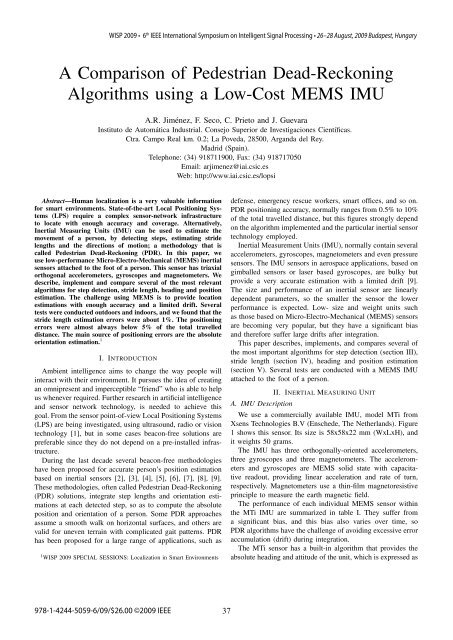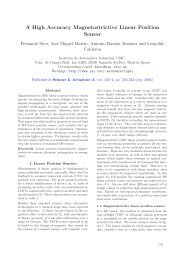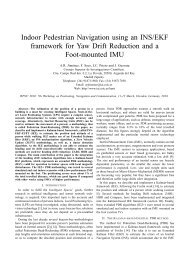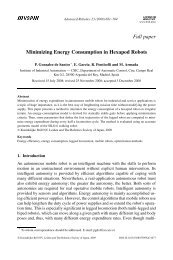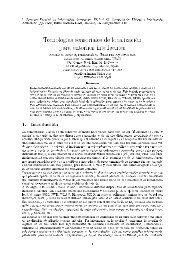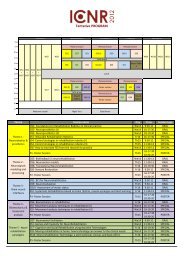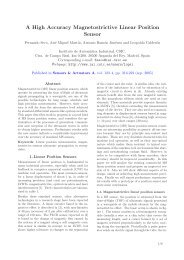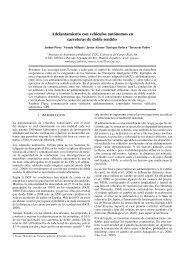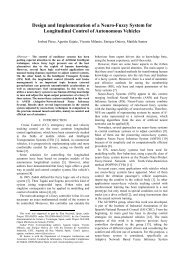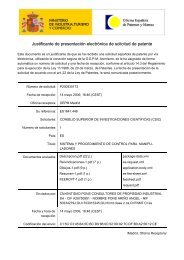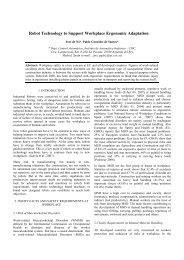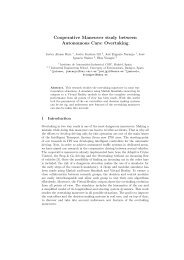A Comparison of Pedestrian Dead-Reckoning Algorithms using a ...
A Comparison of Pedestrian Dead-Reckoning Algorithms using a ...
A Comparison of Pedestrian Dead-Reckoning Algorithms using a ...
You also want an ePaper? Increase the reach of your titles
YUMPU automatically turns print PDFs into web optimized ePapers that Google loves.
WISP 2009 • 6 th IEEE International Symposium on Intelligent Signal Processing • 26–28 August, 2009 Budapest, HungaryStride Length (m)1.81.61.41.2Weiberg SLSLalgorithmWeibergZUPTWalking speedError <strong>of</strong> the totaldistance calculatedby summingall SLSlow -1.10 m 0.30%Normal -2.64 m 0.73%Fast 2.81 m 0.78%Slow -2.23 m 0.62%Normal 4.15 m 1.15%Fast -3.47 m 0.97%Error in percentage<strong>of</strong> the totaltravelled distance(360 m)TABLE IVPERFORMANCE OF TWO STRIDE LENGTH (SL) ESTIMATION ALGORITHMS(WEINBERG AND ZUPT) FOR THREE DIFFERENT WALKING SPEEDS.a)10.81.8Fast (estimated)Fast (actual mean)Slow (estimated)Slow (actual mean)Normal (estimated)Normal (actual mean)50 100 150 200 250StepsZUPT SLat stance occurrence i (k) .2) Assuming that IMU X axis is aligned with the footheading, then the foot orientation at stance is:⎛−X G ⎞IMU(west)i(k)θstance k= arctan ⎝⎠XIMU G . (7)(north)i(k)b)Stride Length (m)1.61.41.210.8Fast (estimated)Fast (actual mean)Slow (estimated)Slow (actual mean)Normal (estimated)Normal (actual mean)50 100 150 200 250StepsFig. 5. Stride length estimations for straight trajectories (120 m <strong>of</strong> length) atthree different walking speeds, and repeated 3 times each <strong>of</strong> them. a) WeinbergSL algorithm (K =0.364) [7], b) ZUPT SL algorithm [2].speeds. The ZUPT method gives also good results with alarger variation between consecutive SL; this is because ZUPTmethod does not filter any signal as Weiberg SL method does.The total travelled distance, at a given walking speed, wasestimated by integrating all the individual SL estimations.Comparing them with the actual distances we found veryaccurate results as summarized in table IV. Both SL methodsgive errors about 1% <strong>of</strong> the total travelled distance.V. 2D POSITION ESTIMATIONA. Positioning algorithmsWe implemented three positioning algorithms. Two <strong>of</strong> themare based on the accumulation <strong>of</strong> foot displacements (estimatedstride lengths SL k ) along the horizontal orientation <strong>of</strong>the foot (θstance k) at each detected step stance . This is thealgorithm:1) Compute the IMU’s X axis in global coordinates,XIMU G = R GSi(k) · [1, 0, 0], for every detected step ki(k)3) The horizontal position P k =(P k (north),P k (east)) <strong>of</strong>the foot at step k is computed as{Pk (north) =P k−1 (north)+SL k · cos(θstance k)P k (east) =P k−1 (east)+SL k · sin(θstance k),(8)where SL k are the stride lengths estimated by any <strong>of</strong> thetwo method presented in last section (eqs. 4 or 6).The third INS-ZUPT-based algorithm for foot position estimationjust accumulates the positioning increments, ΔP k ,obtained with equation 5:{Pk (north) =P k−1 (north)+ΔP k (north)(9)P k (east) =P k−1 (east)+ΔP k (east).B. Outdoors and indoors positioning resultsWe tested the three above-presented positioning algorithmswith several trajectories both outdoors and indoors. Trajectorieshave a length between 100 and 320 meters, and wereclosed, i.e. the finish point coincides with the start position.The same paths were followed in clock-wise (CW) directionand also counter-clock-wise (CCW).After a study <strong>of</strong> more than 30 test trajectories, the errorbetween the final position estimation and the starting point,was in most <strong>of</strong> the cases between 5 to 15 meters, whichaccounts for a percentage <strong>of</strong> the total travelled distance below5%. These final-position errors were similar for all threealgorithms, but slightly worse for the INS-ZUPT method.Figure 6 shows the estimated trajectories <strong>of</strong> an outdoor test,and figure 7 an indoor test in the main building <strong>of</strong> IAI-CSIC.We note in both figures that there is a significant rotationerror in the estimated trajectories; CW for the INS-ZUPTalgorithm based on eq. 9; and a slight angular error CCW inthe algorithms based on SL and foot orientation at stance (eq.8). We know that any orientation error in the latter methods cancome from the misalignment between the foot and the sensor41
A. R. Jiménez et al. • A <strong>Comparison</strong> <strong>of</strong> <strong>Pedestrian</strong> <strong>Dead</strong>-<strong>Reckoning</strong> <strong>Algorithms</strong> <strong>using</strong> a Low-Cost MEMS IMUNorth (m)50403020100Real traj.SL Weiberg+θ stanceSL ZUPT+θ stanceINS ZUPTStart−30 −20 −10 0 10East (m)Fig. 6. An outdoors 160 meter-long closed-CCW trajectory and three positionestimations <strong>using</strong> different PDR algorithms.North (m)50403020100Real traj.SL Weiberg+θ stanceSL ZUPT+θ stanceINS ZUPTStart0 10 20 30 40 50 60East (m)Fig. 7. A trajectory along the main building <strong>of</strong> IAI-CSIC and three positionestimations <strong>using</strong> different PDR algorithms.X axis. This unknown misalignment term could be calibrated,but we presented the raw trajectories.Considering the shape <strong>of</strong> the trajectories, its quality isslightly worse with the INS-ZUPT method. We know that thepositioning results strongly depends on the quality <strong>of</strong> orientationestimations. The INS-ZUPT method uses all orientationsamples in a step (about 80), however the SL + θ methodsuse the orientation at one step sample (the sample at stancedetection). We observed that orientation during swing phaseare not as reliable as orientation at stance, this could explainwhy the SL + θ methods give trajectories with slightly bettershape and accuracy than INS-ZUPT.VI. CONCLUSIONWe have described, implemented and compared some <strong>of</strong>the most relevant algorithms in the state <strong>of</strong> the art for pedestriandead reckoning (PDR). We restricted the study to lowcost,low-performance, low-weight MEMS-based IMU sensorsplaced at the foot <strong>of</strong> a person. The presented results shownthat MEMS IMU with the appropriated algorithms can providegood solutions for estimating human trajectories, with a driftthat is proportional to the travelled distance but not to the timeelapsed. The positioning errors are below 5% <strong>of</strong> the travelleddistance both outdoors and indoors (although it depends onmagnetic disturbances and the walking pattern).The INS-ZUPT positioning method is normally consideredas the most powerful PDR method, since it is able to satisfactorilyestimate while running, with lateral walk or on uneventerrain. However we have seen that in smooth surfaces otherpositioning methods, based on SL plus foot orientations atstance, can be superior and more computationally efficient.Any IMU PDR estimation method needs a periodic calibrationto obtain fine positioning. This update must be donewith absolute position estimates, that could be provided byLPS sensors such as those based on RFID, WiFi, UWB or ultrasound.Future work, will be focused to: 1) integrating PDRmethods with LPS solutions, and 2) matching PDR estimationswith local maps for absolute orientation correction. Any <strong>of</strong>these approaches should provide accurate indoor location <strong>of</strong>persons, valid in the analysis <strong>of</strong> motion in smart environmentsand scenarios such as home, <strong>of</strong>fices, healthcare, emergencies,sports and so on.ACKNOWLEDGMENTThe authors would like to thank the financial supportprovided by projects RESELAI (TIN2006-14896-C02-02) andLOCA (CSIC-PIE Ref.200450E430).REFERENCES[1] A.R. Jiménez, F. Seco, C. Prieto, and J. Roa, “Tecnologías sensorialesde localización para entornos inteligentes,” in I Congreso español deinformática - Simposio de Computación Ubicua e Inteligencia Ambiental,UCAmI2005 (Granada), 2005, pp.75-86.[2] R. Feliz, E. Zalama and J. Gómez, “<strong>Pedestrian</strong> tracking <strong>using</strong> inertialsensors,” Journal <strong>of</strong> Physical Agents, vol. 3 (1), pp. 35-42, 2009.[3] B. Beauregard, “Omnidirectional <strong>Pedestrian</strong> Navigation for First Responders,”in 4th Workshop on Positioning, Navigation and communication,WPNC’07, Hannover, 2007, pp. 33-36.[4] J. Won Kim, H.J. Jang, D. Hwang and C. Park, “A step, stride and headingdetermination for the pedestrian navigation system,” Journal <strong>of</strong> GlobalPositioning Sustems, vol. 3 (1-2), pp.273-279, 2004.[5] R. G. Stirling, “Development <strong>of</strong> a pedestrian navigation system <strong>using</strong>shoe mounted sensors”, Master <strong>of</strong> Science, University <strong>of</strong> Alberta, 2003.[6] R Stirling, J. Collin, K. Fyfe and G. Lachapelle, “An Innovative Shoemounted<strong>Pedestrian</strong> Navigation System”, In GNSS 2003, Graz, Austria,22-25 April, 2003, pp. 1-15.[7] H. Weinberg, “Using the ADXL202 in Pedometer and Personal NavigationApplications,”Analog Devices AN-602 application Note, 2002[8] T.J. Brand and R.E. Phillips, “Foot-toFoot Range Measurement as anAid to Personal Navigation,´´ in ION 59th Annual Meeting, 23-25 June,Alburquerque, NM, 2003, pp. 113-121.[9] L. Ojeda and J. Borestein, “Non-GPS Navigation for Emergency Responders,”In International joint Topical Meeting on Sharing Solutions forEmergencies and Hazardous Environments, February 12-15, Salt LakeCity, Utath, USA, 2006, pp. 1-8.42


